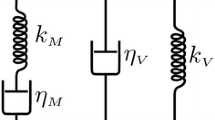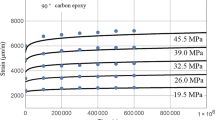A generalization of the physically nonlinear Maxwell-type constitutive equation with two material functions for non-aging rheonomic materials, whose general properties and area of application have been studied analytically in previous articles, was suggested. To extend the set of basic rheological phenomena simulated, a third strain component expressed as the Boltzmann–Volterra linear integral operator governed by an arbitrary creep function was added. For generality and convenience of managing the constitutive equation and its fitting to various materials and lists of effects simulated, a weight factor (degree of nonlinearity) was introduced into the constitutive relation, which enabled to combine the primary physically nonlinear Maxwell-type model with the linear viscoelasticity equation in arbitrary proportion to construct a hybrid model and to regulate the prominence of different phenomena described by the two constitutive equations. A general expression for creep and recovery curves produced by the constitutive equation proposed was derived and analyzed. The general properties of creep and recovery curves were studied assuming three material functions are arbitrary. New properties were established, which enabled the generalized model to adjust the form of creep and recovery curves and to simulate additional effects (in comparison with the primary Maxwell-type model) observed in creep and recovery tests of various materials at different stress levels.



Similar content being viewed by others
References
A. V. Khokhlov, “Two-sided estimates for the relaxation function of the linear theory of heredity via the relaxation curves during the ramp-strain and the methodology of identification,” Mech. Solids, 53, No. 3, 307-328 (2018). DOI: https://doi.org/10.3103/S0025654418070105
A. V. Khokhlov, “Analysis of properties of ramp stress relaxation curves produced by the Rabotnov non-linear hereditary theory,” Mech. Compos. Mater., 54, No. 4, 473-486 (2018). DOI: https://doi.org/10.1007/s11029-018-9757-1
A. V. Khokhlov, “Properties of the set of strain diagrams produced by Rabotnov nonlinear equation for rheonomous materials,” Mech. Solids, 54, No. 3, 384-399 (2019). DOI: https://doi.org/10.3103/S002565441902002X
A. V. Khokhlov, “Long-term strength curves generated by the nonlinear Maxwell-type model for viscoelastoplastic materials and the linear damage rule under step loading,” J. Samara State Tech. Univ., Ser. Phys. & Math. Sci., 20, No. 3, 524-543 (2016). doi: https://doi.org/10.14498/vsgtu1512
A. V. Khokhlov, “The nonlinear Maxwell-type model for viscoelastoplastic materials: simulation of temperature influence on creep, relaxation and strain-stress curves,” J. Samara State Tech. Univ., Ser. Phys. & Math. Sci., 21, No. 1, 160-179 (2017). doi:https://doi.org/10.14498/vsgtu1524
A. V. Khokhlov, “A nonlinear Maxwell-type model for rheonomic materials: stability under symmetric cyclic loadings,” Moscow Univ. Mech. Bull., 73, No. 2, 39-42 (2018). doi:https://doi.org/10.3103/S0027133018020036
A. V. Khokhlov, “Applicability indicators and identification techniques for a nonlinear Maxwell-type elasto-viscoplastic model using multi-step creep curves,” Vestn. Mosk. Gos. Tekh. Univ. im. N. E. Baumana, Estestv. Nauki [Herald of the Bauman Moscow State Tech. Univ., Nat. Sci.] No. 6, 92-112 (2018). doi: https://doi.org/10.18698/1812-3368-2018-6-92-112
A. V. Khokhlov, “Applicability indicators and identification techniques for a nonlinear Maxwell-type elastoviscoplastic model using loading-unloading curves,” Mech. Compos. Mater., 55, No. 2, 195-210 (2019). doi:https://doi.org/10.1007/s11029-019-09809-w
A. V. Khokhlov, “Possibility to describe the alternating and nonmonotonic time dependence of Poisson’s ratio during creep using a nonlinear Maxwell-type viscoelastoplasticity model,” Russ. Metallurgy (Metally), No.10, 956-963 (2019). doi:https://doi.org/10.1134/S0036029519100136
A. V. Khokhlov, O. N. Stolyarov, A. V. Shaporev, “Loading-unloading-recovery curves for polyester yarns and identification of the nonlinear Maxwell-type viscoelastoplastic model,” Mech. Compos. Mater., 59, No. 1, 129-146 (2023). doi: https://doi.org/10.1007/s11029-023-10086-x
Yu. N. Rabotnov, Creep of Structural Elements [in Russian], M., Nauka (1966).
I. I. Bugakov, Creep of Polymeric Materials [in Russian], M., Nauka (1973).
N. N. Malinin, Calculations for the Creep of Elements of Machine-Building Structures [in Russian], M., Mashinostroenie (1981).
D. A. Gokhfeld and O. S. Sadakov, Plasticity and Creep of Structural Elements Under Repeated Loading [in Russian], M., Mashinostroenie (1984).
A. F. Nikitenko, Creep and Long-Term Strength of Metallic Materials [in Russian], Novosibirsk, NGASU (1997).
J. Betten, Creep Mechanics, Berlin, Heidelberg, Springer-Verlag (2008).
A. M. Lokoshchenko, Creep and Long-Term Strength of Metals [in Russian], M., Fizmatlit (2016).
R. S. Lakes, Viscoelastic Materials, Cambridge Univ. Press (2009).
J. S. Bergstrom, Mechanics of Solid Polymers. Theory and Computational Modeling, Elsevier, William Andrew (2015).
G. V. Vinogradov and A. Ya. Malkin, Rheology of Polymers [in Russian], M., Khimiya (1977).
R. G. Larson, Constitutive Equations for Polymer Melts and Solutions, Butterworth, Boston (1988).
R. K. Gupta, Polymer and Composite Rheology, N.Y., Marcel Dekker (2000).
A. Y. Malkin and A. I. Isayev, Rheology: Conceptions, Methods, Applications (2nd Ed.), Toronto, Chem. Tec. Publishing (2012).
H. F. Brinson and L. C. Brinson, Polymer Engineering Science and Viscoelasticity, Springer Science and Business Media (2008).
A. E. Kalinnikov and A. V. Vakhrushev, “On the creep of materials with different resistance to tension and compression at variable stresses,” Mech. Compos. Mater., No. 3, 400-405 (1982).
A. Fatemi and L. Yang, “Cumulative fatigue damage and life prediction theories: A survey of the state of the art for homogeneous materials,” Int. J. Fatigue, 20, No. 1, 9-34 (1998).
A. Launay, M. H. Maitournam, Y. Marco, I. Raoult, and F. Szmytka, “Cyclic behavior of short glass fiber reinforced polyamide: Experimental study and constitutive equations,” Int. J. Plasticity, 27, 1267-1293 (2011).
M. K. Darabi, R. K. A. Al-Rub, E. A. Masad, C.-W. Huang, and D. N. Little, “A modified viscoplastic model to predict the permanent strain of asphaltic materials under cyclic-compression loading at high temperatures,” Int. J. Plasticity, 35, 100-134 (2012).
H. Takagi, M. Dao, and M. Fujiwara, “Prediction of the constitutive equation for uniaxial creep of a power-law material through instrumented microindentation testing and modeling,” Materials Transactions, 55, No. 2, 275-284 (2014).
N. Q. Chinh and P. Szommer, “Mathematical description of indentation creep and its application for the determination of strain rate sensitivity,” Mater. Sci. and Eng., A, 611, 333-336 (2014).
D. S. Petukhov and I. E. Keller, “Dual problems of plane creeping flows of a power-law incompressible medium,” Vestn. Samara Gos. Tekhn. Univ. Ser. Fiz.-Mat. Nauki, 20, No. 3, 496-507 (2016).
O. A. Kaibyshev, Superplasticity of Industrial Alloys [in Russian], M., Metallurgia (1984).
T. G. Nieh, J. Wadsworth, and O. D. Sherby, Superplasticity in Metals and Ceramics, Cambridge Univ. Press (1997).
K. A. Padmanabhan, R. A. Vasin, and F. U. Enikeev, Superplastic Flow: Phenomenology and Mechanics, Berlin, Heidelberg, Springer-Verlag (2001).
V. M. Segal, I. J. Beyerlein, C. N., Tome, V. N. Chuvil’deev, and V. I. Kopylov, Fundamentals and Engineering of Severe Plastic Deformation, N.Y., Nova Science Pub. Inc. (2010).
A. P. Zhilayev and A. I. Pshenichnyuk, Superplasticity and Grain Boundaries in Ultrafine-Grained Materials, Cambridge Intern. Sci. Publ. (2010).
Y. Cao, “Determination of the creep exponent of a power-law creep solid using indentation tests,” Mech. Time Dependent Mater., 11, 159-172 (2007).
M. Megahed, A. R. S. Ponter, and C. J. Morrison, “An experimental and theoretical investigation into the creep properties of a simple structure of 316 stainless steel,” Int. J. Mech. Sci., 26, No. 3, 149-164 (1984).
F. U. Enikeev, “Experimental evaluation of the velocity sensitivity of a superplastic material with a highly inhomogeneous stress-strain state,” Zavodskaya Lab., Mater. Diagn., 73, No. 10, 44-50 (2007).
A. V. Mikhaylovskaya, A. A. Kishchik, A. D. Kotov, et al., “Precipitation behavior and high strain rate superplasticity in a novel fine-grained aluminum based alloy,” Mater. Sci. Eng. A, 760, 37-46 (2019).
M. E. Eglit, A. E. Yakubenko, and Yu.S. Zaiko, “Mathematical modeling of slope flows taking into account the non-Newtonian properties of a moving medium,” Trudy V. A. Steklov Matemat. Inst. RAS, 300, 229-239 (2018).
V. P. Radchenko and D. V. Shapievsky, “Mathematical model of creep of a micro-inhomogeneous nonlinear elastic material,” PMTF, 49, No. 3, 157-163 (2008).
K. Naumenko, H. Altenbach, and Y. Gorash, “creep analysis with a stress range dependent constitutive model.,” Arch. Appl. Mech., 79, 619-630 (2009).
L. Y. Lu, G. L. Lin, and M. H. Shih, “An experimental study on a generalized Maxwell model for nonlinear viscoelastic dampers used in seismic isolation.,” Eng. Struct., 34, No. 1, 111-123 (2012).
M. D. Monsia, “A simplified nonlinear generalized maxwell model for predicting the time dependent behavior of viscoelastic materials,” World J. Mech., No. 1, 158-167 (2011). doi:https://doi.org/10.4236/wjm.2011.13021
A. M. Stolin and A. V. Khokhlov, “Nonlinear model of shear flow of thixotropic viscoelastic-plastic continua, taking into account the evolution of the structure, and its analysis,” Moscow Univ. Mech. Bull., 77, No.5, 127-135 (2022). DOI: https://doi.org/10.3103/s0027133022050065
V. A. Gorodtsov and A. I. Leonov, “On kinematics, nonequilibrium thermodynamics and rheological relations in the nonlinear theory of viscoelasticity,” PMM, 32, No. 1, 70-94 (1968).
A. I. Leonov, E. Ch. Lipkina, E. D. Paskhin, and A. N. Prokunin, “Theoretical and experimental investigations of shearing in elastic polymer liquids,” Rheol. Acta, 15, No. 7/8, 411-426 (1976).
V. A. Palmov, “Rheological models in nonlinear mechanics of deformable bodies,” Adv. in Mech., 3, No. 3, 75-115 (1980).
A. N. Prokunin, “On nonlinear constitutive relations of Maxwellian type for describing the motion of polymer liquids,” PMM, 48, No. 6, 957-965 (1984).
A. I. Leonov and A. N. Prokunin, Nonlinear Phenomena in Flows of Viscoelastic Polymer Fluids, London, Chapman and Hall (1994).
A. I. Leonov, “Constitutive equations for viscoelastic liquids: Formulation, analysis and comparison with data,” Rheology Series, 8, 519-575 (1999).
A. V. Khokhlov, “Analysis of creep curves produced by the linear viscoelasticity theory under cyclic stepwise loadings,” J. Samara State Tech. Univ., Ser. Phys. Math. Sci., 21. No. 2, 326-361 (2017). doi:https://doi.org/10.14498/vsgtu1533
Author information
Authors and Affiliations
Corresponding author
Rights and permissions
Springer Nature or its licensor (e.g. a society or other partner) holds exclusive rights to this article under a publishing agreement with the author(s) or other rightsholder(s); author self-archiving of the accepted manuscript version of this article is solely governed by the terms of such publishing agreement and applicable law.
About this article
Cite this article
Khokhlov, A.V. Generalization of a Nonlinear Maxwell-Type Viscoelastoplastic Model and Simulation of Creep and Recovery Curves. Mech Compos Mater 59, 441–454 (2023). https://doi.org/10.1007/s11029-023-10107-9
Received:
Revised:
Published:
Issue Date:
DOI: https://doi.org/10.1007/s11029-023-10107-9




